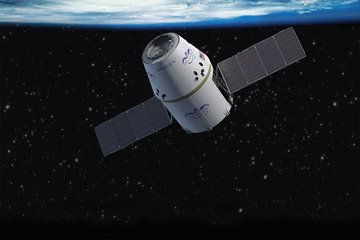
The first commercially contracted re-supply mission to the International Space Station (ISS) has begun.
A Falcon rocket carrying a Dragon cargo capsule lifted clear of Cape Canaveral in Florida at 20:35 (00:35 GMT).
The robotic Dragon ship will deliver 400 kg of food, clothing, experiments and spares to the orbiting platform’s six astronauts.
It is the maiden flight in a sequence of 12 missions that California’s SpaceX company is performing for NASA.
NASA is looking to the private sector to assume routine transport duties to and from low-Earth orbit.
It has given SpaceX a $1.6 billion contract to keep the ISS stocked up with essentials, restoring a re-supply capability that the US lost when it retired the shuttles last year.
The terms of the contract kicked in following a successful test of Dragon’s systems in May.
That demonstration saw the capsule berth with the ISS – the first commercially designed and built vehicle to do so – and then return safely to Earth.
NASA has a second company it hopes also can soon begin operational cargo deliveries to the station.
The Orbital Sciences Corporation (OSC) will shortly test its new Antares rocket before undertaking its own ISS demonstration with a robotic vessel called Cygnus.
If that mission – tipped to take place next year – goes well then it will trigger a $1.9 billion contract for Orbital.
NASA wants eventually to put astronaut transport in the hands of the private sector, too.
SpaceX is eyeing this business as well, and is developing the critical life-support and safety systems that would turn Dragon into a human-rated vehicle. The company says it is just a few years away from being able to provide an astronaut “taxi” service.
NASA’s policy of outsourcing its cargo and crew transport needs is intended to find savings that can be ploughed back into building a rocket and capsule system capable of taking humans beyond low-Earth to more challenging destinations.
“We’re handing off to the private sector our transportation to the International Space Station so that NASA can focus on what we do best – exploring even deeper into our Solar System, with missions to an asteroid and Mars on the horizon,” explained agency administrator Charles Bolden.
Sunday’s nine-minute, 14-second ascent to orbit appeared flawless.
The Falcon dropped the Dragon off in an elliptical path running from 197 km above the Earth out to 328 km.
“Dragon was inserted into a picture-perfect orbit,” said SpaceX president Gwynne Shotwell.
“Its solar arrays deployed and it’s driving its way to station. So, that’s just awesome.”
Dragon must raise itself to the ISS’s altitude, which is presently at more than 400 km.
It is scheduled to arrive at the station on Wednesday. It will follow the routine established in May of parking itself just below the platform so that it can be grabbed by a robotic arm and pulled into a berthing port.
The attachment should take place at about 05:40 GMT.
Dragon is expected to return to Earth at the end of the month.
Its cargo then will include broken machinery and science materials that need to be handed back to researchers.